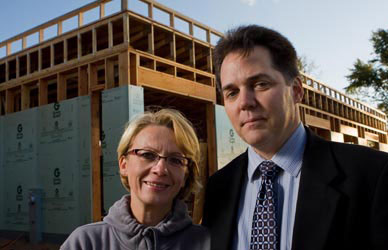


The major energy producers of their home come in the form of a geothermal heat pump and sun-tracking solar panels. The pump uses the naturally stable temperature of the earth, which is always around 55 degrees, to heat and cool the home. The solar panels will provide electricity, and the Chambers hope these panels can generate enough extra to send back through the power grid to be used by their neighbors.
As Tom and Verona stroll through their partially constructed home, their detailed explanations paint a vivid picture of the countless other energy-efficient techniques working together to achieve energy freedom. Tom pounds on the 2-by-8 studs, 4 inches wider than a normal home to provide room for extra insulation. Inside the walls, he describes, an intricate copper piping system will create a more efficient method for delivering hot water throughout the home. He rubs the firm polystyrene that envelops the entire house, including the basement, providing extra insulation. He moves toward the hole where a door would eventually go, indicating the home will be as airtight as possible to keep warm air in during Wisconsin’s trying winters. He gestures toward the roof, which will soon be covered with white rubber to reflect sunlight and keep the house cool during Wisconsin’s equally extreme summers.
They note the flat roof under the rubber is for purely aesthetic reasons and go on to describe the modernist design they incorporated into their plan. “For American eyes, I’m a little worried, because it is very, very modern,” Verona says.
The south-facing windows were designed to be thin horizontally and vertically in order to maximize sun exposure while minimizing the view of the less-attractive front yard. A minimalist approach to living led to an open floor design that will include a sparsely furnished kitchen and living room, ENERGY STAR appliances and even a kitchen table constructed partly from recycled wood.
Their 1,750 square feet of living space is considerably smaller than the 2,479-square-foot average in the United States, but for the couple it is the perfect size. “What you see is what it is,” Verona says. “It’s just the two of us, so this is the area we are going to live in. We try to keep it compact but high enough so you feel comfortable.”
Behind the complex research and design, tucked away in a small, quiet town, the Chambers’ one-story home touts a simple purpose. Using nature’s most basic powers – the sun and the earth – to live sustainably in Wisconsin.
Home I Mind I Body I Soul I Site Map
About Us I Contact Us I Business Partners I Archives
Copyright 2008 Curb Magazine